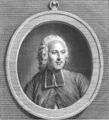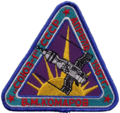Template:Selected anniversaries/April 24: Difference between revisions
No edit summary |
No edit summary |
||
| Line 1: | Line 1: | ||
<gallery> | <gallery> | ||
||1620 | ||1620: John Graunt born ... demographer and statistician. | ||
File:Thomas Fincke.jpg|link=Thomas Fincke (nonfiction)|1656: Mathematician and physicist [[Thomas Fincke (nonfiction)|Thomas Fincke]] dies. He introduced the modern names of the trigonometric functions tangent and secant. | File:Thomas Fincke.jpg|link=Thomas Fincke (nonfiction)|1656: Mathematician and physicist [[Thomas Fincke (nonfiction)|Thomas Fincke]] dies. He introduced the modern names of the trigonometric functions tangent and secant. | ||
File:Jean-Antoine Nollet.jpg|link=Jean-Antoine Nollet (nonfiction)|1746: Priest, physicist, and practical joker [[Jean-Antoine Nollet (nonfiction)|Jean-Antoine Nollet]] discharges a battery of Leyden jars through a human chain, unexpectedly generating [[gray light]], although the causes of [[gray light]] (in this case, electrical stimulation of [[Gnomon algorithm]] computation) are poorly understood at the time. | |||
||Robert-Aglaé Cauchoix (b. 24 April 1776) was a French optician and instrument maker, whose lenses played a part in the race of the great refractor telescopes in the first half of the 19th century. Pic: observatory. | ||Robert-Aglaé Cauchoix (b. 24 April 1776) was a French optician and instrument maker, whose lenses played a part in the race of the great refractor telescopes in the first half of the 19th century. Pic: observatory. | ||
| Line 40: | Line 40: | ||
||1922 – The first segment of the Imperial Wireless Chain providing wireless telegraphy between Leafield in Oxfordshire, England, and Cairo, Egypt, comes into operation. | ||1922 – The first segment of the Imperial Wireless Chain providing wireless telegraphy between Leafield in Oxfordshire, England, and Cairo, Egypt, comes into operation. | ||
|| | ||1942: Leonid Kulik dies ... minerologist who conducted the first scientific expedition (for which records survive) to study the Tungusta meteor impact site. He began in 1927, and continued to work on the investigation until, while fighting for his country in WW II, he was captured and died of typhus in a Nazi prison camp. Pic. | ||
||1944 | ||1944: Georg Bredig dies ... physical chemist. Pic. | ||
|| | ||1944: Charles Jordan dies ... magician. | ||
|| | ||1945: Ernst-Robert Grawitz dies ... physician. | ||
||Hendrik Anthony "Hans" Kramers | ||1947: Roger D. Kornberg born ... biochemist and academic, Nobel Prize laureate. (Alive August 2018.) | ||
||1952: Hendrik Anthony "Hans" Kramers dies ... physicist who worked with Niels Bohr to understand how electromagnetic waves interact with matter. | |||
File:Soyuz 1 patch.png|link=Soyuz 1 (nonfiction)|1967: Cosmonaut Vladimir Komarov dies in [[Soyuz 1 (nonfiction)|Soyuz 1]] when its parachute fails to open. He is the first human to die during a space mission. | File:Soyuz 1 patch.png|link=Soyuz 1 (nonfiction)|1967: Cosmonaut Vladimir Komarov dies in [[Soyuz 1 (nonfiction)|Soyuz 1]] when its parachute fails to open. He is the first human to die during a space mission. | ||
||1960 | ||1960: Max von Laue dies ... physicist and academic, Nobel Prize laureate. | ||
||1964 | ||1964: Gerhard Domagk dies ... pathologist and bacteriologist. | ||
||Vladimir Mikhaylovich Komarov | ||1967: Vladimir Mikhaylovich Komarov dies ... test pilot, aerospace engineer and cosmonaut. In October 1964, he commanded Voskhod 1, the first spaceflight to carry more than one crew member. He became the first cosmonaut to fly in space twice when he was selected as the solo pilot of Soyuz 1, the first manned test flight of a new spacecraft. A parachute failure caused his Soyuz capsule to crash into the ground after re-entry on 24 April 1967, making him the first human to die in a space flight. Pic. | ||
||1980 | ||1980: Eight U.S. servicemen die in Operation Eagle Claw as they attempt to end the Iran hostage crisis. | ||
||1990 | ||1990: STS-31: The Hubble Space Telescope is launched from the Space Shuttle Discovery. | ||
||1997 | ||1997: Eugene Stoner dies ... engineer, designed the AR-15 rifle. | ||
||George Michael Volkoff | ||2000: George Michael Volkoff dies ... physicist and academic who helped, with J. Robert Oppenheimer, predict the existence of neutron stars before they were discovered. Pic. | ||
</gallery> | </gallery> | ||
Revision as of 16:53, 15 August 2018
1656: Mathematician and physicist Thomas Fincke dies. He introduced the modern names of the trigonometric functions tangent and secant.
1746: Priest, physicist, and practical joker Jean-Antoine Nollet discharges a battery of Leyden jars through a human chain, unexpectedly generating gray light, although the causes of gray light (in this case, electrical stimulation of Gnomon algorithm computation) are poorly understood at the time.
1863: Printer, inventor, and crime-fighter Édouard-Léon Scott de Martinville patents new type of phonoautograph, which records crimes against mathematical constants as photographic images.
1914: The Franck–Hertz experiment, a pillar of quantum mechanics, is presented to the German Physical Society.
1915: Miniaturized version of John Ambrose Fleming delivers lecture from within Fleming tube.
1967: Cosmonaut Vladimir Komarov dies in Soyuz 1 when its parachute fails to open. He is the first human to die during a space mission.





